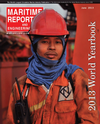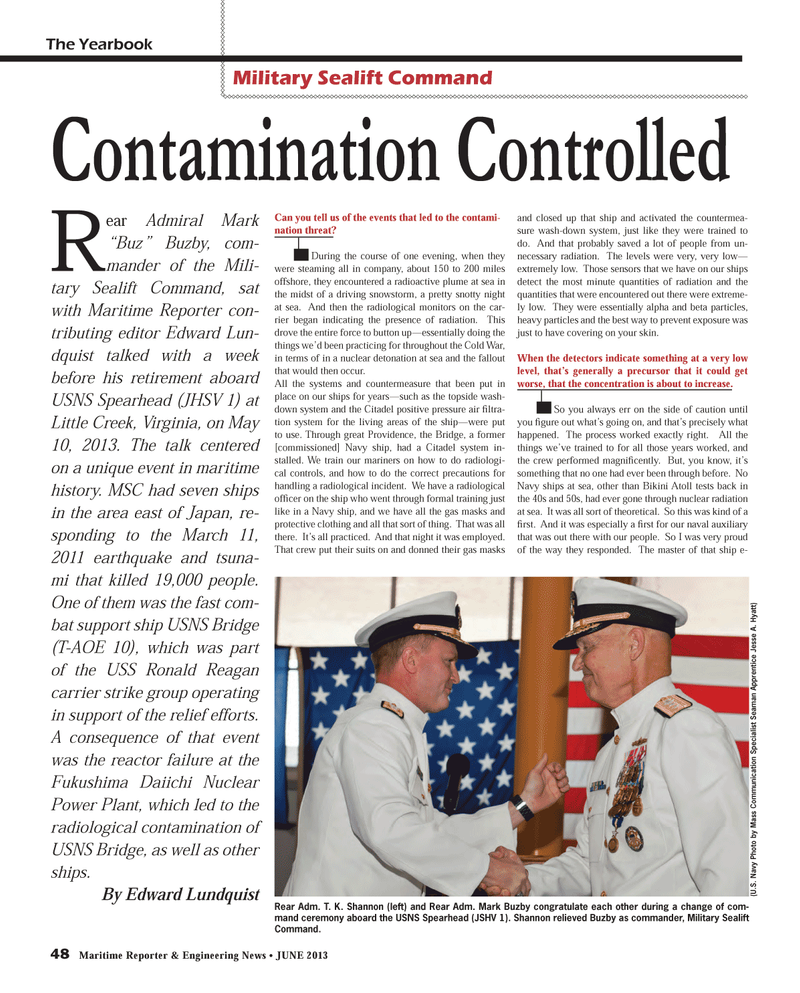
Page 48: of Maritime Reporter Magazine (June 2013)
Annual World Yearbook
Read this page in Pdf, Flash or Html5 edition of June 2013 Maritime Reporter Magazine
48 Maritime Reporter & Engineering News ? JUNE 2013 Can you tell us of the events that led to the contami-nation threat? During the course of one evening, when they were steaming all in company, about 150 to 200 miles offshore, they encountered a radioactive plume at sea in the midst of a driving snowstorm, a pretty snotty night at sea. And then the radiological monitors on the car- rier began indicating the presence of radiation. This drove the entire force to button up?essentially doing the things we?d been practicing for throughout the Cold War, in terms of in a nuclear detonation at sea and the fallout that would then occur. All the systems and countermeasure that been put in place on our ships for years?such as the topside wash-down system and the Citadel positive pressure air Þ ltra-tion system for the living areas of the ship?were put to use. Through great Providence, the Bridge, a former [commissioned] Navy ship, had a Citadel system in-stalled. We train our mariners on how to do radiologi- cal controls, and how to do the correct precautions for handling a radiological incident. We have a radiological ofÞ cer on the ship who went through formal training just like in a Navy ship, and we have all the gas masks and protective clothing and all that sort of thing. That was all there. It?s all practiced. And that night it was employed. That crew put their suits on and donned their gas masks and closed up that ship and activated the countermea-sure wash-down system, just like they were trained to do. And that probably saved a lot of people from un- necessary radiation. The levels were very, very low? extremely low. Those sensors that we have on our ships detect the most minute quantities of radiation and the quantities that were encountered out there were extreme-ly low. They were essentially alpha and beta particles, heavy particles and the best way to prevent exposure was just to have covering on your skin.When the detectors indicate something at a very low level, that?s generally a precursor that it could get worse, that the concentration is about to increase. So you always err on the side of caution until you Þ gure out what?s going on, and that?s precisely what happened. The process worked exactly right. All the things we?ve trained to for all those years worked, and the crew performed magniÞ cently. But, you know, it?s something that no one had ever been through before. No Navy ships at sea, other than Bikini Atoll tests back in the 40s and 50s, had ever gone through nuclear radiation at sea. It was all sort of theoretical. So this was kind of a Þ rst. And it was especially a Þ rst for our naval auxiliary that was out there with our people. So I was very proud of the way they responded. The master of that ship e- The YearbookMilitary Sealift CommandContamination Controlled Rear Admiral Mark ?Buz? Buzby, com- mander of the Mili-tary Sealift Command, sat with Maritime Reporter con-tributing editor Edward Lun- dquist talked with a week before his retirement aboard USNS Spearhead (JHSV 1) at Little Creek, Virginia, on May 10, 2013. The talk centered on a unique event in maritime history. MSC had seven ships in the area east of Japan, re- sponding to the March 11, 2011 earthquake and tsuna- mi that killed 19,000 people. One of them was the fast com-bat support ship USNS Bridge (T-AOE 10), which was part of the USS Ronald Reagan carrier strike group operating in support of the relief efforts. A consequence of that event was the reactor failure at the Fukushima Daiichi Nuclear Power Plant, which led to the radiological contamination of USNS Bridge, as well as other ships.By Edward LundquistRear Adm. T. K. Shannon (left) and Rear Adm. Mark Buzby congratulate each other during a change of com- mand ceremony aboard the USNS Spearhead (JSHV 1). Shannon relieved Buzby as commander, Military Sealift Command. (U.S. Navy Photo by Mass Communication Specialist Seaman Apprentice Jesse A. Hyatt) MR #6 (42-49).indd 48MR #6 (42-49).indd 485/31/2013 9:49:34 AM5/31/2013 9:49:34 AM

 47
47

 49
49
